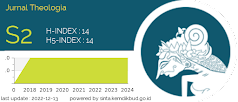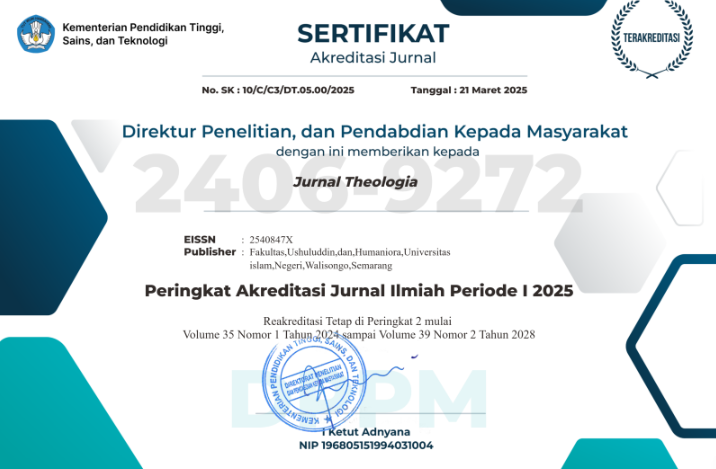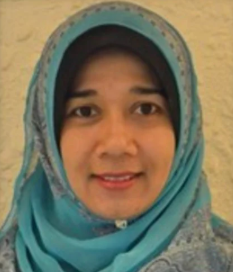Offering Rituals (Sesajen): Synthesis of Religion and Culture from the Perspective of Islamic Religious Groups
DOI:
https://doi.org/10.21580/teo.2023.34.2.18157Keywords:
offering ritual, ancestral spirits, supernatural, sacred.Abstract
This research examines the community's offering rituals to honor gods, ancestral spirits, and guardian spirits of sacred places. This ritual caused controversy among Muslims because it contained elements of shirk. This research aims to seek a synthesis of this controversy. This research uses a qualitative descriptive method approach with an ethnographic type. Data collection was carried out through observation and interviews. Data analysis uses interactive methods. The research results show that offering rituals can be synthesized from a religious and cultural perspective with the following conditions: 1) offering rituals are positioned as cultural events, not as offerings as in religion; 2) the meaning of the offering ritual is thanksgiving which is consumed by the community, not left to be eaten by spirits or ancestral spirits because it would be wasteful; 3) the intention of the offering ritual is only for Allah alone and is not mixed or added with other names. As in religion, the intention of sacrifice is for Allah alone, but the object (sacrificial animal) is for humans.
Downloads
References
Adam, Ujang Kusandi, Andreian Yusup, Salma Fauziyyah Fadlullah, and Siti Nurbayani. “Akulturasi Budaya – Agama Serta Keselarasan Dalam Budaya Sesajen Di Kampung Cipicung Girang.” Sosietas Jurnal Pendidikan Sosiologi Akulturasi Budaya – Agama Serta Keselarasan Dalam 9, no. 1 (2019): 637–47. http://ejournal.upi.edu/index.php/sosietas/.
Adam, Ujang Kusnadi, Andreian Yusup, Salma Fauziyyah Fadlullah, and Siti Nurbayani. “Sesajen Sebagai Nilai Hidup Bermasyarakat Di Kampung Cipicung Girang Kota Bandung.” Indonesian Journal of Sociology, Education, and Development 1, no. 1 (2019): 27–35. https://doi.org/10.52483/ijsed.v1i1.3.
Adawiyah, Siti Rubay’atul. “Upacara Adat Ngasa Di Kampung Budaya Jalawastu Dalam Perspektif Teologis.” Jurnal Riset Agama 2, no. 1 (2022): 200–219. https://doi.org/10.15575/jra.v2i1.17124.
Alfiah, Lailul, Salsabilla Libnatus Asfarina, and Moh. Fuad Ali Aldinar. “Pemberian Sesajen Untuk Ritual Ruwah Desa Perspektif Hukum Islam.” Ma’mal: Jurnal Laboratorium Syariah Dan Hukum 3, no. 1 (2022): 1–17. https://doi.org/10.15642/mal.v3i1.118.
Alkaf, Mukhlas. “Berbagai Ragam Sajen Pada Pementasan Tari Rakyat Dalam Ritual Slametan.” Jurnal Seni Budaya Gelar 11, no. 2 (2013): 211–23. file:///C:/Users/asus/Downloads/1469-4307-1-PB (1).pdf.
Aminullah, Aminullah. “Sinkretisme Agama Dan Budaya Dalam Tradisi Sesajen Di Desa Prenduan.” Dirosat : Journal of Islamic Studies 2, no. 1 (2017): 1. https://doi.org/10.28944/dirosat.v2i1.64.
Anis, Madhan. “Suran: Upacara Tradisional Dalam Masyarakat Jawa.” Jurnal Seuneubok Lada 2 (2014): 53–60.
Dr. Ayatullah Humaeni, MA, MA. Eneng Purwanti, MA. Azizah Awaliyah, B.Ed, and Rom. Sesajen: Menelusuri Makna Dan Akar Tradisi Sesajen Masyarakat Muslim Banten Dan Masyarakat Hindu Bali. 3rd ed. LP2M UIN SMH Banten, 2021.
Edward, Marco, and Elia Shabani Mligo. “The Contribution of African Traditional Sacrifices towards Solving Existential Problems : A Case of the Sukuma People in Shinyanga Region TEKU Journal of Interdisciplinary Studies ( TJIS ) The Contribution of African Traditional Sacrifices Towards Solving.” TEKU Journal of Interdisciplinary Studies (TJIS) Vol. 1, no. 1 (2021): 11–19. https://www.researchgate.net/publication/353935183_The_Contribution_of_African_Traditional_Sacrifices_towards_Solving_Existential_Problems_A_Case_of_the_Sukuma_People_in_Shinyanga_Region.
Firmansyah, Wahid, Muhammad Kurniawan Budi Wibowo, Baehaqi, and Meti Fatimah. “Hukum Sesajen dalam Pesta Pernikahan Menurut Perspektif Hukum Islam.” Mamba’ul ’Ulum 19, no. 1 (2023): 80–91. file:///C:/Users/asus/Downloads/8.+JURNAL+WAHID.pdf.
Haniyaturroufah. “Ritual Sesaji Sebagai Bentuk Persembahan Untuk Kanjeng.” Bahasa Dan Sastra Jawa 03, no. 05 (2013): 20–23. http://ejournal.umpwr.ac.id/index.php/aditya/article/download/755/729.
Ida Sulastri, Suharti. “Sesaji Kupat dalam Tradisi Gumbregan di Desa Kemiri Kecamatan Tanjungsari Kabupaten Gunungkidul.” Jurnal Penelitian Humaniora 22, no. 1 (2017): 57–70. file:///C:/Users/asus/Downloads/19102-47376-1-PB.pdf.
Idrus, Muhammad. Metode Penelitian Ilmu Sosial Pendekatan Kualitatif Dan Kuantitatif. 2nd ed. Jakarta: Erlangga, 2009.
Imam Muslim. Shohih Muslim, n.d.
Katsir, ’Imadudin Abi al-Fida Isma’il ibn. Tafsir Al-Qur’an Al-Karim. Semarang: Toha Putra, n.d.
Kustomo, Febi Agustina. “Nilai-Nilai Sosial Dan Budaya Tradisi.” In Third Conference on Research and Community Services, CORCYS, STKIP PGRI Jombang Berinovasi Di Masa Pandemi “Penelitian Dan Pengabdian Masyarakat Di Era Kampus Merdeka-Merdeka Belajar,” 630–40, 2021. https://ejournal.stkipjb.ac.id/index.php/CORCYS/article/download/2064/1684.
Mas’udi, Mas’udi. “Kerukunan dalam Keanekaragaman: Struktur Keberagamaan Masyarakat Pucakwangi.” Jurnal THEOLOGIA 29, no. 2 (2018): 243–70. https://doi.org/10.21580/teo.2018.29.2.2449.
Miharja, Deni, Endah Wahidah, and Yeni Huriani. “Makna Ritual Sesajen dalam Ajar Pikukuh Sunda (Sunda Wiwitan) (Sudi Terhadap Penganut Ajar Pikukuh Sunda Di Padepokan Bumi Dega Sunda Academy Bandung.” Living Islam: Journal of Islamic Discourses 4, no. 2 (2021): 125–42.
Miles, M. B., & Huberman, A. M. “Qualittaive Data Analysis.” News.Ge. California: SAGE Publications, Inc., 2014.
Mohammad Siddiq, Hartini Salama. “Etnografi Sebagai Teori Dan Metode.” Kordinat 18, no. 1 (2019)
https://journal.uinjkt.ac.id/index.php/kordinat/article/view/11471/5781.
Musa, Abu Yahya Marwan bin. “Tafsir Al Qur’an Hidayatul Insan Jilid 1.” Tafsir Al Qur’an Al Karim 4 (2016)
Qamaruddin Shaleh, Dahlan, MD Dahlan. Asbabun Nuzul, Latar Beakang Historis Turunnya Ayat Ayat Al Qur’an. 5th ed. Bandung: Diponegoro, 1985.
RI, Kemenag. “Tafsir Web - Surat Al-Ma’idah Ayat 27,” n.d. https://tafsirweb.com/1911-surat-al-maidah-ayat-27.html.
Riyadi, Abdul Kadir. “Tasawuf Dalam Cengkeraman Materialisme Historis: Kajian Pemikiran Husein Muruwwa.” Jurnal THEOLOGIA 31, no. 2 (2020): 277–312. https://doi.org/10.21580/teo.2020.31.2.6746.
Roibin, Roibin. “Dialektika Agama Dan Budaya Dalam Tradisi Selamatan Pernikahan Adat Jawa Di Ngajum, Malang.” El-HARAKAH (TERAKREDITASI) 15, no. 1 (2013): 34. https://doi.org/10.18860/el.v15i1.2671.
Sugiyono. Metode Penelitian Kuantitatif, Kualitatif Dan Kombinasi (Mixed Methods). 2nd ed. Bandung: Alfabeta, 2018.
Sulistiyowati, Tutut Indah. “Tradisi, Edukasi, Dan Konservasi Dalam Ritual Ngunggahne Beras Warga Desa Jugo Kecamatan Mojo Kabupaten Kediri.” Sinkesjar, 2022
https://proceeding.unpkediri.ac.id/index.php/seinkesjar/article/view/2985.
Teresia Noiman Derung, Maria Frameliza Zefanya, Yohanes Emanuel Bisu, Martina Dhale. “Studi Analisis Pengalaman Krisis Manusia Dalam Misteri Ritual Sesajen Jawa Ditinjau Dari Sosiologi Agama Menurut Weber.” In Theos: Jurnal Pendidikan Agama Dan Teologi 2, no. 10 (2022): 334–44. https://doi.org/https://doi.org/10.56393/intheos.v2i3.1278.
Umaya Ratna , Cahya, Imam Setyobudi. “Ritual Numbal Dalam Upacara Ruwatan Bumi Di Kampung Banceuy-Subang.” Jurnal Budaya Etnika 3, no. 1 (2019): https://jurnal.isbi.ac.id/index.php/etnika/article/download/1126/745.
Wahyuni, Sri, and Idrus Alkaf. “Makna Tradisi Sesajen Dalam Pembangunan Rumah Masyarakat Jawa : Studi Kasus Pembangunan Di Desa Srimulyo Kecamatan Air Saleh Kabupaten Banyuasin” 1, no. 2 (2020)




















